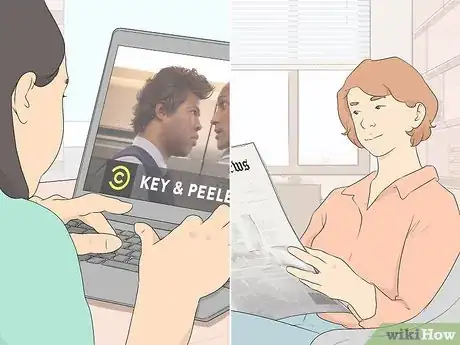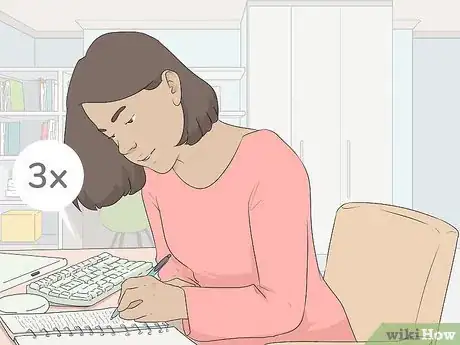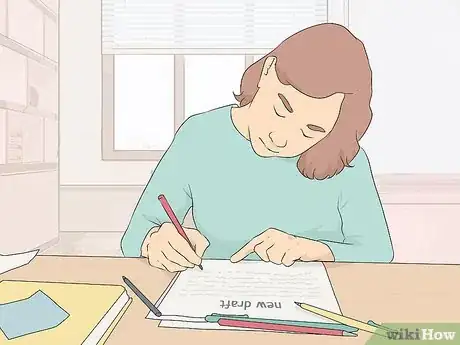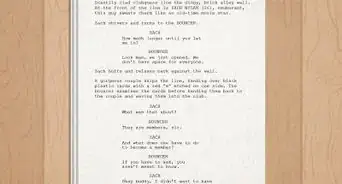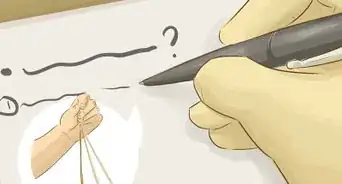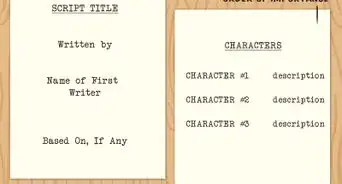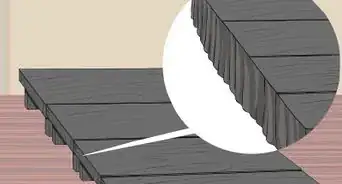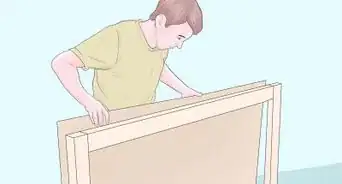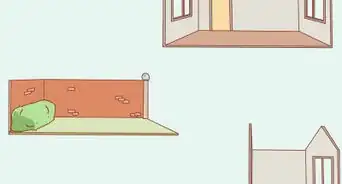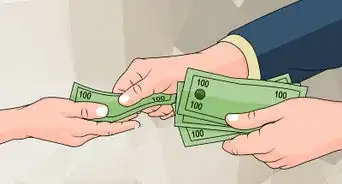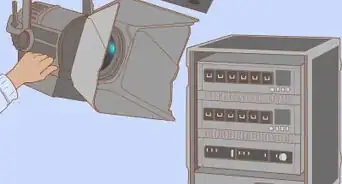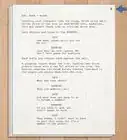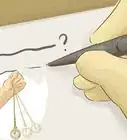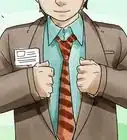This article was co-authored by Kendall Payne. Kendall Payne is a Writer, Director, and Stand-up Comedian based in Brooklyn, New York. Kendall specializes in directing, writing, and producing comedic short films. Her films have screened at Indie Short Fest, Brooklyn Comedy Collective, Channel 101 NY, and 8 Ball TV. She has also written and directed content for the Netflix is a Joke social channels and has written marketing scripts for Between Two Ferns: The Movie, Astronomy Club, Wine Country, Bash Brothers, Stand Up Specials and more. Kendall runs an IRL internet comedy show at Caveat called Extremely Online, and a comedy show for @ssholes called Sugarp!ss at Easy Lover. She studied at the Upright Citizens Brigade Theatre and at New York University (NYU) Tisch in the TV Writing Certificate Program.
This article has been viewed 498,936 times.
A skit is a short play or performance. Skits are quick little scenes that are usually comedic. Skits are also sometimes referred to as sketches. To make a skit, start by thinking of ideas that make you laugh. Write out your scene, rehearse, and finally put it on for an audience or film it.
Steps
Developing an Idea
-
1Gather inspiration. Sometimes you have a skit idea that just comes to you out of nowhere, other times, you have to go searching for an idea. Gather inspiration for your skit by watching and reading other comedy sketches. You can go onto YouTube and watch videos of sketches which are produced both professionally, and in an amateur sense.[1]
- Watch sketches by Key & Peele, SNL, W/ Bob and David, and Monty Python to gather inspiration. Take note on what these professional sketches have in common. What separates these sketches from other ones?
- When watching other sketches or skits, think about what makes the one you're watching original. You don’t want to copy a skit you’ve seen before, but you may be able to find a new angle.
- Pay attention to what’s happening around you. A lot of the best skits work because there is a relatable component in the sketch that makes us think of our own lives. Pay attention to how people around you interact with one another. Look for real life scenarios that are funny to you.[2]
-
2Brainstorm ideas. Write down a bunch of ideas. You can do this with a group of people who are going to be working on the skit, by yourself, or both. Grab a notebook that you can carry around with you and jot down ideas as new ones come to you.[3]
- If you encounter a funny interaction between people, that might be a great starting idea for a skit. For example, you witness someone at a coffee shop ordering an overly complicated drink and holding up the line. Write down what happened and why you think there might be humor in this situation. Maybe the idea of ordering such a complicated coffee is funny to you.
- Meet with your group and share ideas. It’s good If you have a place to write your ideas down so everyone can see each idea. Otherwise, designate someone to write each idea down in a notebook.
- Don’t censor your ideas right now. At this stage, you just want to get everything out. You may find that one silly idea turns into something great.
- If you laugh at an idea, make a note that you thought it was funny. Ask yourself why you’re laughing. Is it something visual about the idea? A certain word or words? Or maybe it’s because the idea is relatable to your own life. Knowing why something made you laugh will be helpful when building out your skit and ultimately performing it.
- Think about what kind of skit you may want to do. There are a number of types of skits and sketches from parody and satire, to character sketches and even absurdist sketches.
Advertisement -
3Develop your point of view. Every successful skit or sketch has a solid point of view (POV) that can be easily identified. It’s the same principal as having a thesis statement in a paper. Your POV should be easy for people to understand. A POV is the lens in which viewers of your skit see the world as you see it. In a sketch, this can be blown up for comical effect.
- A POV is your opinion expressed as a fact. You can discover your point of view through a couple steps. First, you see someone order an overly complicated drink at a coffee shop. Second, you decide to write a skit about people ordering complicated drinks at a coffee shop. Each drink that a new person in your skit orders is more complicated and ridiculous than the one before it. Third, you reach your point of view, which is that people are becoming too obsessed with unnecessary options and materialism.
- Your point of view isn’t expressed by one character in your skit complaining about someone ordering an overly complicated drink. It’s expressed by the action that takes place in your skit.
- Having a clear point of view and expressing it as a fact is a great way to make any skit more original. Even if the content of the skit has been done before, it’s original enough because it comes from you.
-
4Outline a beginning, middle, and end. Every story, no matter how short needs a beginning, middle, and end. When writing a skit try and map out these three different sections.
- Since skits are usually comedic in nature, your beginning can depict normal, everyday life. People at a coffee shop waiting in line to order coffee is normal.
- The middle of your sketch happens when something out of the norm occurs. People start ordering crazier drinks than the person before.
- The end of your skit is when there’s a climax and resolution. Perhaps the barista decides to dump everyone’s coffee on the ground. Or maybe the barista snaps and takes out a weapon and steals the money from the cash register.
Writing Your Skit
-
1Write a first draft. There are several formats to writing skits and sketches. You don’t have to have a professional format, but you should have an easy to follow one.
- The top of your script should have the title of your skit. Below you may want to write out the names of the characters involved, and even the name of the actor playing that character.
- To write dialogue, center and capitalize the character’s name who is speaking. On the next line, left indent the cursor and type the dialogue.
- Actions can be written on a separate line in parentheses.
- When writing your first draft, don’t concern yourself too much with getting everything perfect. You just want to get the general script down. You will edit it later.
-
2Get into your skit quickly. Whether you’re filming or performing your skit live, your skit will most likely be under five minutes in length. This means that you have to get into the meat of your skit quickly. Don’t spend time setting up characters and backgrounds. Simply start at a point which is funny or where the action is happening.
- If you’re writing the coffee shop skit, try beginning your skit with the barista asking the person at the front of the line what this person wants to order.
- The person who orders the drink should describe a complicated drink but not something that is so crazy that you can’t begin to build on it as the next few people order drinks.
- At the top of your skit, your goal is to give your audience enough information as quickly as possible. The barista can say something like “Welcome to Good Coffee, what can I get for you?” With one line you have established where you are, who the characters are, and what is happening.
- In a skit, every line is important. You don’t have time to waste developing elements that don’t matter in this scenario. Avoid discussion of things in the past/future, people who aren’t present, and objects that aren’t relevant to the skit.
-
3Keep it short. Keep your script to less than five pages. If you go over five pages in your first draft, that’s fine, you can cut parts out. On average, one page of a script equals one minute of performance time.
- You also want to keep your skit short because you can lose the humor if you drag it on for too long. A fast-paced script that ends quickly is easier to stay engaged in than a skit that stops being funny because the joke has run its course.
-
4Remember the rule of three. The rule of three means that you repeat something three times, or include three similar elements into your skit. [4] [5] It’s like having your beginning, middle, and end, you have three components making up a whole.
- In our coffee shop skit, you can have three different patrons buying coffee. Each patron has a more ridiculous order than the last.
-
5Build the action up. When writing your script you want to start at a place that you can build on. A skit should have a rising action before hitting the climax and then ending.
- Using our coffee shop example, the first person will order a complicated drink. You can have the barista and customer talk for a few lines. Maybe the barista tries repeating the drink back to the customer and gets part of it wrong. The customer then has to correct the barista.
- The second customer has a crazier drink order. The barista tries repeating the drink order back and the customer decides to change the order. The barista then tries repeating this order back or has to ask what one of the ingredients is because it’s not common in a coffee drink. The customer complains and moves on.
- Finally, the third customer comes up. The barista is already upset and confused by the first two orders. The third order is by far the most outlandish order. The barista tells the customer that the coffee shop doesn’t even carry half of the ingredients and that the remaining options are black coffee, or coffee with cream. The customer throws a fit and calls for the manager.
- Now the barista has finally snapped and acts in a way that is just as crazy as the customers only with real life implications. This could mean the barista robs the coffee shop, throws hot coffee in the customer’s faces, or gets fired.
-
6Keep working on new drafts. After you write your first draft, read it out loud to your group, assigning each person a character. Then get feedback and discuss what everyone thought did, and did not work.
- Show your sketch to someone whose opinion you trust. It’s good to get feedback from someone who will give you an honest opinion.
- Take notes on what people thought was funny, and not funny. It’s a good idea to understand what doesn’t work in a skit. Though you may like a line or joke, it may not work in your skit.
- Cutting out what doesn’t work is a great way to trim the fat in a skit. You want your skit to be lean and quick. Consider removing lines of dialogue that don’t directly contribute to forwarding your skit.
Performing or Filming Your Skit
-
1Hold auditions. Depending on how serious you are about producing your skit or sketch, you may want to hold auditions for actors. If you wrote your skit with a group and already know who is going to perform you don’t have to hold auditions, but you should do a read through.
- Although you should be looking for talented people, you should also find people that you know can be reliable and trustworthy. You don't want to hold empty practices and rehearsals.
- If you are writing a skit as part of a larger show at school or a theatre, ask your teacher or theatre director for information about auditions. There might be one large audition set up for everyone, or you may have to hold your own.
- If you are holding auditions, put signs up around your school or post information about it on social media.
- When you do hold auditions, ask actors to bring in a headshot. You should also provide sides, which are a few pages of your script, for the actors to read.
-
2Schedule at least one rehearsal. Since your skit is short you don’t need to have many rehearsals, but one or two is always a good idea. Make sure that your actors know the lines and understand the direction and point of view of your skit.
- Plan for your props and other equipment. Some skits work best with no props or backgrounds while others need a few more theatrics. Skits by definition aren't too elaborate, but there may be props required to make the skit make sense.
-
3Perform or film your skit. When you’ve rehearsed your skit a few times, it’s time to perform it live or shoot it for the web. Give yourself plenty of time to make sure that any props, costumes, and camera equipment are set.
- If you’re filming your skit, you should have at least one camera, as well as sound and lighting equipment if you can.
- You can also upload your skit to YouTube or Vimeo so others can view it.
Sample Skits
Community Q&A
-
QuestionCould a kid make a skit?
 Community AnswerYes. Anyone could make a skit. Age doesn't matter, as the old saying goes.
Community AnswerYes. Anyone could make a skit. Age doesn't matter, as the old saying goes. -
QuestionWhat stuff should be prepared before I act out a skit/play?
 Community AnswerEverything that you need to put the skit on, i.e. scripts, props, costumes, etc.
Community AnswerEverything that you need to put the skit on, i.e. scripts, props, costumes, etc. -
QuestionWhat kind of jokes do you use for comedy skits?
 Community AnswerPuns and jokes using irony are your best options or jokes with no background information but are funny on the spot.
Community AnswerPuns and jokes using irony are your best options or jokes with no background information but are funny on the spot.
References
- ↑ Kendall Payne. Writer, Director, & Stand-up Comedian. Expert Interview. 3 April 2020.
- ↑ Kendall Payne. Writer, Director, & Stand-up Comedian. Expert Interview. 3 April 2020.
- ↑ Kendall Payne. Writer, Director, & Stand-up Comedian. Expert Interview. 3 April 2020.
- ↑ http://tvtropes.org/pmwiki/pmwiki.php/Main/RuleOfThree
- ↑ Kendall Payne. Writer, Director, & Stand-up Comedian. Expert Interview. 3 April 2020.
About This Article
To make a great comedic skit, take the time to brainstorm funny ideas, outline what you're going to say, then practice performing until it's perfect! Before you sit down to write, look for inspiration from events in your daily life. For example, someone holding up a line at a coffee shop because of their complicated order could turn into a skit that’s funny and relatable. Once you have an idea, create an outline it with a beginning, middle, and end. Use this outline to write a rough draft where the action or comedy gradually ramps up. For instance, in the coffee shop skit, there could be 3 different customers, and each one has a more complicated and outlandish order than the person before them. Keep revisiting your draft and make edits that make it quicker and funnier. When you're satisfied with your draft, find some friends to act in it and practice until you’re ready to film it with a camera or smartphone. For more help, like how to give your skit a personal point of view, read on.
